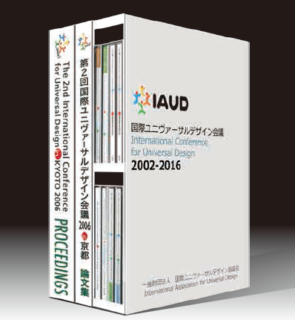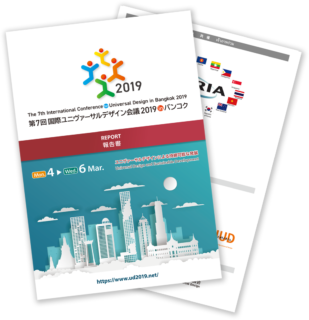2025.05.29
Day 1: October 12 (Friday)
2012.10.20 Updated
Opening Ceremony

The conference began with a moment of silence for the late HIH Prince Tomohito and the late IAUD President Takuma Yamamoto, both of whom passed away this year. Regular proceedings of the 4th International Conference for Universal Design 2012 in FUKUOKA then commenced with HIH Princess Yoko in attendance. An opening address from IAUD Vice President Tetsuo Iku was followed by the reading of a message from Prime Minister Noda and addresses by Fukuoka Prefecture Governor Hiroshi Ogawa and Fukuoka City Mayor Soichiro Takashima. It was truly an opening ceremony that reflected the high expectations of IAUD's guests and members for the conference. Speakers at the opening ceremony affirmed the conference objectives to make the most of the lessons learned from the Great East Japan Earthquake disaster, to reflect on the fundamental principles of UD to create safe and secure environments for all, and to take advantage of the strategic location of the host city of Fukuoka as a launch pad for spreading the principles of UD throughout Asia.

IAUD Vice President
Tetsuo Iku

Her Imperial Highness
Princess Yoko

Reading the message
from Prime Minister Noda

Fukuoka Prefecture Governor
Hiroshi Ogawa

Fukuoka City Mayor
Soichiro Takashima
Memorial Lecture: "New Challenges for Universal Design"
Kazuo Toda (Adviser of the Council, IAUD: Japan)

After attendants expressed their gratitude to the late HIH Prince Tomohito for his significant contribution to UD in a moment of silence, IAUD Adviser Kazuo Toda related various events which occurred in the history of IAUD under the guidance of HIH Prince Tomohito since the establishment of IAUD. In a brief review of the first through the third IAUD international conferences, he then spoke of the details and achievements of those conferences and reaffirmed their significance. Adviser Toda also expressed his gratitude for the support the rest of the world extended to Japan at the time of the Great East Japan Earthquake disaster and called upon his fellow countrymen to cooperate with other countries in overcoming various issues through the humanistic approach of UD. At the same time, he appealed to Japanese to promote the disaster readiness of their country as a country that already experienced nuclear bomb, tsunami, and nuclear plant disasters.
Keynote Speech 1: "Line between Normal and Abnormal"
Ayako Sono (Author: Japan)

Speaking largely from her own personal experiences, Ms. Sono talked about providing support for people in difficult circumstances around the world. Introducing case studies in Africa, she spoke of her own hands-on experience in activities there. She also described the cultural and social differences with Japan. Referring to disasters suffered by Japan, she noted how well off the country is today compared with immediately after the Second World War and how Japan today enjoys a special environment unmatched by many countries of the world. Ms. Sono concluded her speech by suggesting that Japan learn from the positive practices and systems of other countries to make Japan a country where the elderly can participate more actively in society.
Keynote Speech 2: "Reflect upon the Future of Japanese Cities and Architecture from the Disaster-Stricken Area in Tohoku"
Toyo Ito (Architect/Visiting Professor, Tama Art University: Japan)

Defining barrier free as the removal of "walls," Mr. Toyo Ito introduced innovative examples of barrier-free architecture. One of these was Sendai Media Take, where functional barriers were removed to create an open shared space, and this resulted in creating an invigorating environment for the elderly. In another example where functional walls were removed, he described how the height of a high-rise building provided for natural air-conditioning. In a further example where privacy walls were removed in a common dwelling, he related a very moving episode about the creation of space for interaction in the Minnano Ie (Everyone’s House), which was constructed as temporary housing after the Great East Japan Earthquake disaster.
Panel Discussion: UD Preparing Against Disaster

Various issues encountered at disaster sites up until now were discussed from the perspective of individual specialists and suggestions were made for effective measures in the future.

Miho Mazereeuw (Lecturer, Massachusetts Institute of Technology: USA)
In her report accompanied by field study data, Dr. Mazereeuw described how the height of breakwaters, the length of escape routes, the inclination of sloping roads, stairways and traffic congestion can all become barriers in times of disaster. She indicated that while escaping on foot may be effective in certain circumstances, it also posed numerous problems. She also questioned the feasibility of disaster-specific facilities with high maintenance costs due to their exclusive use in extraordinary circumstances.
As a measure for addressing this problem, she proposed "universal access" and presented a park design that could be incorporated into town planning as an amenity for everyday use. In this design, the time spent moving from place to place was reduced to a minimum and gradual slopes were used throughout the park.
Dr. Mazereeuw also proposed securing a traffic flow line that can access an area of a certain height (upper connection) as well as the establishment of a secondary emergency evacuation site (that doubles as a food storage facility).

Taro Tamura (Representative, Institute for Human Diversity Japan: Japan)
Reporting on the design of temporary housing for disaster readiness, Mr. Taro Tamura talked about the increase in pneumonia and cardiac infarction as causes of death during evacuation and at emergency evacuation sites. As factors contributing to the incidence of throat and vascular problems among evacuees, he cited people’s reduced intake of water and their avoidance of going to the toilet due to difficulties in accessing toilets that often required walking through long hallways or up and down staircases as well as people’s reluctance to use Japanese-style toilets or toilets in dark locations.
Noting that the basic concept in temporary housing in Japan is to provide shelter for a few days’ stay in the event of flood or typhoon, Mr. Tamura stated the current design is not suitable for long-term stays following a major earthquake or other disaster. He also indicated many design issues in cases where temporary housing designed for two years’ use as a standard was used for periods as long as five years in the case of the Kobe earthquake disaster. Among the issues cited were the appropriateness of the design for everyday life and the use of a structure similar to those used at construction sites. Mr. Tamura also questioned whether unit-baths were necessary for each individual structure or whether people would prefer communal baths. Moreover, he indicated issues of poor drainage and humidity due to the use of park sites and former rice paddies as temporary housing sites.
As other possible health issues to be considered, he indicated the possible emergence of liver disorders in men in their 50s due to lack of work opportunities and heart and vascular diseases in women in their 80s.

Rama Gheerawo (Deputy Director, Helen Hamlyn Centre for Design, Royal College of Art: UK)
Indicating issues arising in times of disaster, insurgency, and terrorism, Dr. Rama Gheerawo discussed the diversity of people, the need to respect their human rights at minimum, and the effectiveness of protecting privacy. He then reported on various cases of exclusion of people during disasters due to differences in nationality, religion, and culture. Speaking about international characteristics in UD, he emphasized the importance of the designer's participation in solutions to suit specific purposes, such as the use of tents that turn to concrete when water is applied as a form of temporary housing or wheelchairs that can be folded. He said the collaboration of both designer and developer in considering various disaster scenarios was vital.

Hua Dong (Professor by Special Appointment, Tongji University: China/ Senior Lecturer, Brunel University: UK)
Hua Dong presented the following key concepts in her discussion of efficient methods of UD development in times of disaster.
- Methods of using objects not considered in ordinary situations (= innovative use)
Consider use within a context, without the use of electric power
Use within one context may not be applicable in another: consider diversity - Concepts from the perspective of participation, experience, equal standing
Appropriateness: appropriate technology - Transfer of authority to the people
Consideration based on values, professional viewpoints, and the viewpoint of ordinary citizens (= diversity)
For example, when it comes to housing, a mechanism for architects and residents to plan together is essential.

Fumiyo Kojima (Chairman of the Board of Directors, IAUD)
After listening to a report on the activities of the Research & Development Planning Division, all attendants took part in a general discussion. Following are some of the key words of the discussion.
Key words in the discussion
- Disaster and communication
- Effective radio broadcasts, isolation of Latino immigrants (Los Angeles earthquake)
Listening to knowledgeable children (Sri Lanka earthquake)
Signage for meals
Wearing backpacks from the beginning (wisdom in not differentiating, design for elderly people to take home) - Cultural and regional differences
- Separating common and individual use
Communication
Context, sharing, open mind
The 48 Hour Marathon for Universal Design Presentations/Awards Ceremony


 Directors in charge
Directors in charge
- Director Makino (left)
- Director Fujiki (right)
- A-Team: Bookerchief (Users: visually impaired)
- Book-style handkerchief
When it comes to maintaining personal hygiene, everybody is the same. People also enjoy dressing for the occasion.
Proposal that respects the user's sensitivity
- B-team: Niwaka (Users: mobility impaired)
- Adhesive IC card
Proposal for smooth transport based on observation of a user's unnatural movement when boarding or exiting public transport
- C-Team: PITAT (Users: wheelchair users)
- Communication-type IC card
Based on their observations of wheelchair users using buses, the team realizes the time required for bus drivers and others to respond to the needs of wheelchair users using public transport.
Proposal for smoother transport through an early alert system that informs the bus driver in advance from a bus stop about the presence of a wheelchair user
- D-Team: MOMOCHI WALK (Users: wheelchair users)
- Area design to allow wheelchair users to enjoy aesthetically pleasant areas (Momochi Hama) safely (Universal Design)
- E-Team: OCHOCO (Users: wheelchair users)
- Realization of a potter's passionate desire: creation of a necklace-style saké cup!
Hakata is renowned for its excellent saké and we wanted everyone to enjoy saké tasting at various sites with this specially designed cup.
- F-Team: Tekotoba T (Users: visually impaired)
- Communication using a T-shirt designed with sign language hand movement motifs
"Tekotoba" proposal as an introduction to sign language
Sharing the experience of sign language through the use of a T-shirt that encourages people to try signing

Best Presentation Award: F-Team

Best Design Award: A-Team

Director Kojima presents trophies to the winning teams

Comments from Professor Arai, Kanazawa College of Art
Wonderful results were achieved by skillfully bringing together the wisdom of young people in Fukuoka.
The user participation model was functioning very effectively.
- Actual onsite observation and the process of listening to the users functioned well (user verification)
- We were able to reaffirm the importance of informal, casual thoughtfulness, a spirit of mutual empathy, and a spirit of sharing with everyone

Comments from Fukuoka City Mayor Takashima
The all-inclusive participation model design definitely achieved positive outcomes here in Fukuoka City.
It was wonderful to see people of various fields of expertise getting together to engage in discussion in a friendly atmosphere.
Welcome Concert
The Western Air Defense Force Band of Japan's Air Self Defense Force displayed colourful, disciplined performing techniques in a medley of brass band marches, children's songs and theme music from popular TV dramas.

Musical pieces performed:
- March: "Grand March Celebration" (Composed by Ikuma Dan)
- Children's Song "Sunayama" (Composed by Shimpei Nakayama)
- Music medley from long-running NHK TV drama series Tenchi Jin (2009), Ryoma Den (2010), Go (2011), Shinsen Gumi (2004) and Atsu Hime (2008)
- March "Air Self-Defense Force March"
The "Grand March Celebration" in particular was composed to celebrate the marriage of the Emperor of Japan when he was still the Crown Prince in 1959 and is very representative of Japanese march music. This march was also played at the Tokyo Olympics in 1964, the Los Angels Olympics in 1984, and various imperial household events such as at the Sokui-no-rei enthronement ceremony in 1990 and at the wedding ceremony of HIH Princess Sayako in 2005.


Welcome Reception

International UD Conference Organizing
Committee Member
Iwashita
A reception with HIH Princess Yoko in attendance was held to welcome participants to the conference and to provide an opportunity for stakeholders and conference participants to deepen their friendship through lively conversation.
Program
- IAUD Council Member Iwashita (member of International UD Conference Organizing Committee): Opening greeting on behalf of the organizers of the conference
- Fukuoka Prefecture Governor Ogawa (joint organizer): Welcome speech
- Fukuoka City Mayor Takashima (joint organizer): Welcome speech
- Fukuoka Chamber of Commerce & Industry President Sueyoshi: Welcome speech
- Kyushu Railway Company Chairman Ishihara: Welcome speech and toast

Fukuoka Prefecture
Governor Ogawa

Fukuoka City
Mayor Takashima

Fukuoka Chamber of
Commerce & Industry
President Sueyoshi

Kyushu Railway Company
Chairman Ishihara

Scenes at the reception
Index >> to Day 2
Inquiries
![]() Please make your inquiry here (you will be automatically transferred to the Inquiries page).
Please make your inquiry here (you will be automatically transferred to the Inquiries page).








